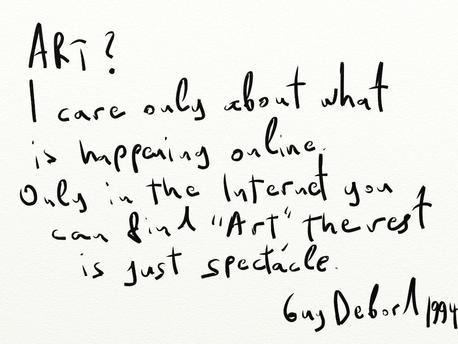Listening with eyes, seeing with ears.
The Visual Music Archive is a non-institutional and highly subjective collection of inspirational works from the ever expanding field of Visual Music.
"Have you seen the new library? There's nothing but computers. There's not a book to be seen. I don't know where to begin, Buffy. I mean, who do we speak to?" – "I believe the sub-text here is rapidly becoming... text." (Rupert Giles, Buffy the Vampire Slayer).
"It is is completely commercial-free and it will always stay that way. All labour and editorial work is voluntary; no money changes hands." (Kenneth Goldsmith, UbuWeb)
To seek completeness in the field of fine arts seems rather eerie.
A wunderkammer, on the other hand, is far more interesting, challenging, and provides inspiring impulses.
As a library's inner sanctum.
"To hear with eyes belongs to love's fine wit." (William Shakespeare, Sonnet 23)
What is Visual Music?
I was never fully content with the relations of my own films and their sound. I saw in every sound track a form of compromise and each presented a dilemma. Many viewers sense an incompatibility here and argue for no sound at all. Yet another argument is noteworthy. The eye, as a witness to events in nature, expects a matching sound with each event. Why should a visual experience, so close to music as these films, happen in silence? We think of dance and opera as a matter of course. On the other hand, apart from the obvious traditions that music and paintings are both wholly self-sufficient, why not a musical experience to be shared with, and equally involving, the eye? Why not visual color patterns which are so constructed as to weave with aural patterns in a fruitful complementary of architecture? The interrelationship might be as elaborate and the consort as true as violin and piano which discourse in the typical partnership of all duo or multi-voiced compositions. This would be a partnership that is valid only if the combinations produce interest greater than the separate contribution of either the aural or the visual member.
Here, many will argue that this is exactly the objective often achieved, in the relationship of music with dance. Yet the complementary in my opinion would begin at the very limits of the ideal of dance joined with music and proceed from there. For that ideal is instantly exceeded, simply because of inertia and gravity. The body has more – and the cathode beam has less – size and mass than the sound of a flute.
(Digital Harmony – On the Complementarity of Music and Visual Art by John Whitney, Sr., McGraw-Hill, Peterborough, New Hampshire, 1980, p.91)
There are differently formed visual structures that can be called Visual Music.
- A visualization of music which is the translation of a specific musical composition (or sound) into a visual language, with the original syntax being emulated in the new visual rendition. This can be done with or without a computer. This can also be defined as intermedia.
- A time based narrative visual structure that is similar to the structure of a kind or style of music. It is a new composition created visually but as if it were an aural piece. This can have sound, or exist silent. (...)
- A direct translation of image to sound or music, as images photographed, drawn or scratched onto a film's soundtrack are directly converted to sound when the film is projected. Often these images are simultaneously shown visually. Literally, what you see is also what you hear. (An early example is filmmaker Oskar Fischinger's Ornament Sound experiments c. 1932). (...) This method has been called a pure type of Visual Music.
- A visual composition that is not done in a linear, time-based manner, but rather something more static like a 7'x8' canvas. However, as in Paul Klee, the movement of the painted elements can and have achieved a kind of Visual Music, serving as an artist's visual interpretation of specific music.
("On Curating Recent Digital Abstract Visual Music" by Jack Ox and Cindy Keefer, written for The New York Digital Salon's Abstract Visual Music project. Slight revision, 2008.)
Source: Center for Visual Music
Visual Music, sometimes called colour music, refers to the use of musical structures in visual imagery, which can also include silent films or silent Lumia work. It also refers to methods or devices which can translate sounds or music into a related visual presentation. An expanded definition may include the translation of music to painting; this was the original definition of the term, as coined by Roger Fry in 1912 to describe the work of Wassily Kandinsky.
Visual Music also refers to systems which convert music or sound directly into visual forms, such as film, video or computer graphics, by means of a mechanical instrument, an artist's interpretation, or a computer. The reverse is applicable also, literally converting images to sound by drawn objects and figures on a film's soundtrack. Filmmakers working in this latter tradition include Oskar Fischinger (Ornament Sound Experiments), Norman McLaren, and many contemporary artists. Visual Music overlaps to some degree with the history of abstract film, though not all Visual Music is abstract. There are a variety of definitions of Visual Music, particularly as the field continues to expand. In some recent writing, usually in the fine art world, Visual Music is often confused with or defined as synaesthesia, though historically this has never been a definition of Visual Music. Visual Music has also been defined as a form of intermedia.
Source: Wikipedia
